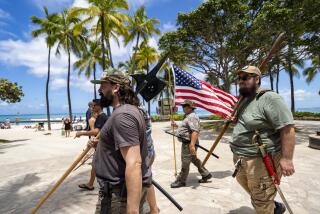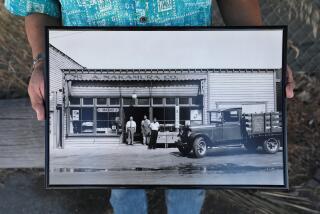Hawaii’s ‘Target Island’ Finds Some Peace : Environment: After 20 years of protests over military bombing practice, Kahoolawe finally has been set aside for cultural, religious and educational uses. Still, there is a lot of cleaning up to be done.
- Share via
HONOLULU — Few places on Earth have been shelled, rocketed and bombed as much as the 45 square miles that make up Kahoolawe, a dry and dusty island hammered for 50 years during target practice by the military.
Assault on the “Target Island” dates back to 1925, when the U.S. Army began using the barren, uninhabited island for military maneuvers.
It reached a peak during World War II, and since then military personnel from other countries have used Kahoolawe for training during Rimpac, which brought together military units from Pacific Rim countries for coordinated maneuvers.
However, after 20 years of protesting, civil disobedience and bitter legal fights, military use of the island was ordered stopped by President George Bush in 1990 and control of the island was returned to the state of Hawaii by the Navy in 1994.
Until the end, military leaders insisted Kahoolawe was vital for training Pacific-area forces.
They hinted its availability could affect decisions on the continued military presence in Hawaii where defense spending is the No. 2 economic mainstay behind tourism.
For native Hawaiians, however, such violent use of the island only 100 miles southeast of heavily populated Honolulu contradicts their aloha ‘ aina-- or love of the land.
It’s a deeply rooted element in the culture that evolved after Polynesians sailed here from the South Pacific to settle some 1,400 years ago.
*
Many modern-day Hawaiians see Kahoolawe’s future as a place for healing, not only the scars on the Earth but of their sophisticated native culture which has been slipping away for generations under a barrage of Western influence.
It’s part of a renaissance of Hawaiian identity and pride and a movement toward a political sovereignty for more than 200,000 Hawaiians and part Hawaiians.
The newly created Kahoolawe Island Reserve Commission has started developing plans for the future uses of the island. A 1993 state law set the island aside exclusively for Hawaiian cultural and religious practices and educational uses.
The law required the island’s transfer to a sovereign native Hawaiian entity once it is created and recognized by the state and federal governments.
In the meantime, the commission is keeping rigid control over trips to the island and is continuing the Navy’s strict rules governing fishing in waters surrounding Kahoolawe, despite protests from commercial and sports fishermen.
“We want to have people respect the island,” said Hawaiian activist Daviana McGregor.
“It’s not an open park, not just another place everyone can go and check out,” he added.
U.S. taxpayers are scheduled to spend $400 million over the next 10 years on the risky cleanup of an untold amount of unexploded ordnance either littering the brush-covered landscape or buried by impact into the island’s dry red dirt.
The Navy will manage the cleanup and retain liability until it is completed.
That much money is enough to clear the surface of the island and remove buried ordnance on about 25% of the island, according to Norma Wong, who negotiated the state’s agreement with the federal government to return the island.
The money also will go to the effort begun 10 years ago to revegetate the heavily eroded island denuded by a combination of fires touched off by munitions and uncontrolled populations of goats, cattle and sheep over years of poor land management.
Title to Kahoolawe, given to the Navy by President Dwight D. Eisenhower in a 1953 executive order, was formally signed back over to the state last May in a dramatic and colorful ceremony eight miles from the island at Palauea Beach on Maui.
*
“Kahoolawe became a symbol of wholeness for me, a celebration of healing, of restoration of a basic tradition for the Hawaiians and a concept that is needed by the rest of the world--aloha ‘aina” said U.S. Sen. Daniel Akaka (D-Hawaii).
“I promised I wouldn’t cry,” said a tearful Dr. Noa Emmett Aluli at the ceremony at Palauea Beach.
Aluli is one of the founders of the Protect Kahoolawe Ohana, which began staging protest landings on the island in 1976.
Aluli, 50, a family physician on the island of Molokai, is chairman of the Kahoolawe Island Reserve Commission.
Aluli says Kahoolawe’s future use will not be restricted to those with Hawaiian blood.
“Not only Hawaiians will be welcomed, but all people of Hawaii who appreciate the Hawaiian traditions can come,” Aluli said. “We have always included non-Hawaiians in our struggles and that has been what has made it acceptable in the community.”
Aluli sees Kahoolawe as “a place for Hawaiians to continue their practice of subsistence living and to worship on a sacred site, a place where, away from distractions, the youth can get in touch early with the practices of their culture. This island will not be turned into golf courses or resorts.”
*
In 1977, Protect Kahoolawe Ohana leader George Helm and member James (Kimo) Mitchell disappeared while using a surfboard to reach the island, martyrs in the cause.
Two others, Walter Ritte Jr. and Richard Sawyer, were sent to prison for six months that year for trespassing on the island, although U.S. District Judge Gordon Thompson commented during sentencing that the “desecration of the island by the bombing that goes on is deplorable.”
It proved to be a pivotal year in the fight as the Navy finally relented and began allowing limited access to Kahoolawe.
U.S. District Judge Dick Yin Wong then ruled the Navy was violating new federal environmental laws by not preparing an environmental impact statement on its use of the island.
He ordered an archeological study.
In 1980, the Department of the Interior found 34 archeological sites on the island eligible for the National Register of Historic Places and in 1981 placed the entire island on the register.
A federal judge then ruled that the Navy had to make sure the bombing and shelling did not damage any archeological sites.
Recently discovered rock carvings dating back 1,000 years indicate Kahoolawe was a navigation center for ancient Hawaiians, whose extensive knowledge of the stars, winds and ocean currents allowed 2,000-mile voyages back and forth to the South Pacific islands.
More to Read
Sign up for Essential California
The most important California stories and recommendations in your inbox every morning.
You may occasionally receive promotional content from the Los Angeles Times.










